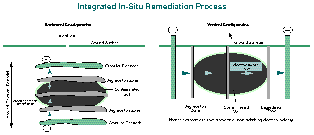


On December 29, 1994, researchers began field testing the LasagnaTM process, a novel method for remediating low permeability, contaminated soils. The tests are being performed at the Paducah Gaseous Diffusion Plant in Paducah, Kentucky. If proven effective, this process, named for its layered structure of treatment zones, will offer a cost-effective, environmentally compatible improvement over existing cleanup options.
The LasagnaTM project is the result of a team effort by three industrial companies and two federal agencies: Monsanto, General Electric, DuPont, the U.S. Department of Energy, and the U.S. Environmental Protection Agency. Their partnership was the result of EPA's Remediation Technology Development Forum (RTDF), a public and private partnership, which enables industry and government agencies to team with a common goal of developing and testing innovative remediation technologies for cleaning up hazardous waste sites. The consortium's activities are facilitated by Clean Sites, Inc. under a Cooperative Research and Development Agreement with EPA's Technology Innovation Office.
Monsanto is the project coordinator and each team member is contributing a different area of expertise to accelerate the research and arrive at a useful solution for all participants. "We are pleased to participate in the RTDF and to help develop the LasagnaTM technology (process) as one potential solution to the tough environmental cleanup problems facing both government and industry. The formation of teams between industry and government is the most cost-effective and rapid approach to the development of remediation technologies," said Jef Walker, Program Manager for DOE's Plume Focus Area. (See the November 1994 issue of Initiatives, "DOE teams up to focus on plumes.")
 The LasagnaTM process involves three phases. First, zones
are created in the soil using sheet piling technology to create
vertical treatment zones or hydraulic fracturing to create
horizontal zones. Sheet piling involves using sheets of metal for
the electrodes. The sheets are driven down into the soil by
methods used in the construction industry. Second, appropriate
materials, such as sorbates, catalytic agents, or microbes are
injected into the treatment zones, creating sorption or
degradation zones. The third component involves applying
low-voltage direct current between buried electrodes to slowly
draw contaminated water out of the silt and clay, forcing it to
migrate toward the negative electrode (cathode). Since the water
doesn't need to reach the electrode, the electric polarity can be
reversed, recirculating the water through the treatment zones.
The LasagnaTM process involves three phases. First, zones
are created in the soil using sheet piling technology to create
vertical treatment zones or hydraulic fracturing to create
horizontal zones. Sheet piling involves using sheets of metal for
the electrodes. The sheets are driven down into the soil by
methods used in the construction industry. Second, appropriate
materials, such as sorbates, catalytic agents, or microbes are
injected into the treatment zones, creating sorption or
degradation zones. The third component involves applying
low-voltage direct current between buried electrodes to slowly
draw contaminated water out of the silt and clay, forcing it to
migrate toward the negative electrode (cathode). Since the water
doesn't need to reach the electrode, the electric polarity can be
reversed, recirculating the water through the treatment zones.
Monsanto has proven that LasagnaTM is effective in the laboratory. DuPont, in conjunction with a subcontractor, has developed the techniques for installing and forming the vertical treatment zones. General Electric has developed a computer modeling program to simulate the field experiments. All three companies are developing proprietary biological and chemical dechlorination approaches which may be used to degrade TCE in the full-scale tests. So far, tests on clean soil in the Paducah area have shown that LasagnaTM can move contaminated water. However, before implementing LasagnaTM as a product for cleaning TCE contaminated soils, researchers must prove its effectiveness through field testing. The Paducah test is being conducted in a 15-foot by 10-foot by 15-foot area. The area is wired and connected to a data acquisition system which will monitor, in real-time, the temperatures, voltages, and currents in the experiment.
Martin Marietta Energy Systems, DOE's integrating contractor for environmental restoration activities at the Paducah Plant, is coordinating the site field activities and is conducting soil sampling and characterization tests. The soil test results will give TCE concentration baseline data. Later soil tests will be compared and evaluated against the baseline tests to evaluate their effectiveness.
The field test should be completed by September 1995. It will allow researchers to evaluate Lasagna'sTM vertical configuration. DOE has made a significant commitment to this $1.4 million field test and is funding 75 percent of the costs through its Research Opportunity Announcement procurement mechanism and the Environmental Restoration Program at Paducah. Twenty-five percent of the project is being funded by Monsanto, DuPont, and General Electric. DOE funding is being used for soil characterization, equipment installation, materials, and the test operation. The funds also enabled the three companies to complete experiments required before the field test. If these tests are successful, it is anticipated that larger field tests of the vertical configuration at contaminated sites will be conducted.
EPA's Risk Reduction Engineering Laboratory in collaboration with the University of Cincinnati, is refining the hydraulic fracturing technology for use in Lasagna'sTM horizontal configuration. Hydraulic fracturing can create pancake-shaped fissures which can be used as horizontal treatment zones. The horizontal configuration should be ready for field testing in 1996. The U.S. Air Force is identifying and evaluating sites for future testing.
![]()